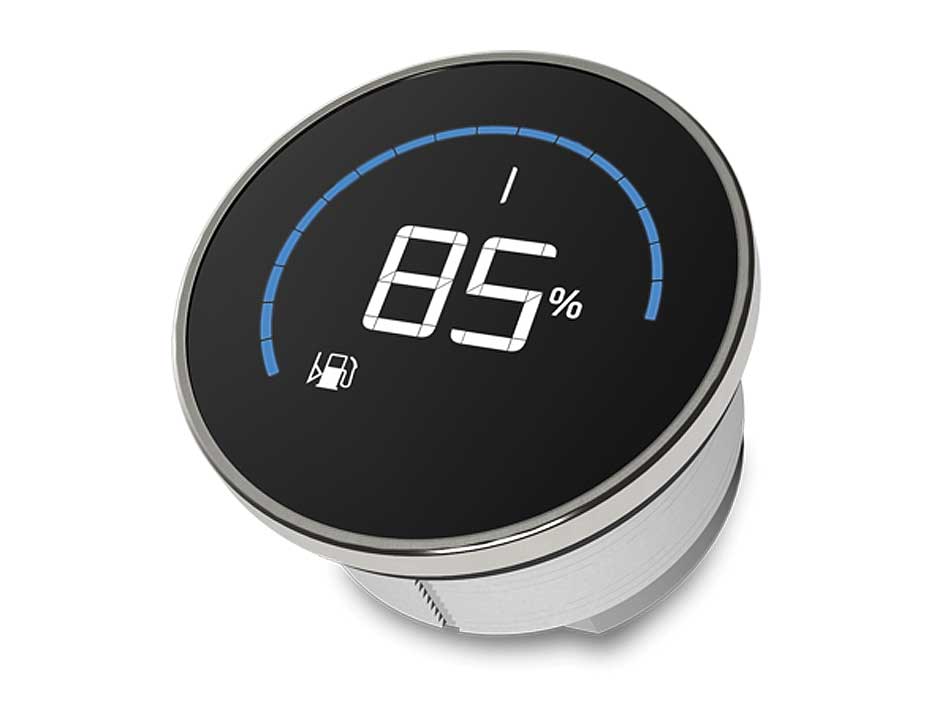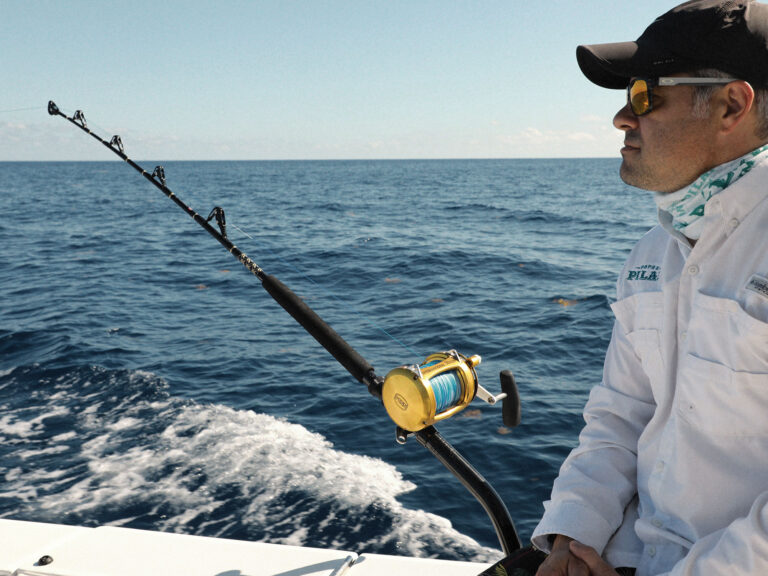
The ActiveTarget live sonar from Lowrance was initially designed for freshwater fishing. But on a trip to test the beta version, Matt Laster, director of the company’s integrated fishing systems, diverted to Key West, Florida, just to see how the system might perform in salt water.
After a couple of days, he called the engineers at the home office with an unexpected report. “You guys were supposed to make a freshwater system,” he announced. “But you messed up and made a saltwater product.”
In Laster’s saltwater field tests, he could see unbelievable underwater action, like a goliath grouper rising from the edge of a wreck to intercept a bait, and a school of blackfin tuna circling near the boat.
His experiences led him to believe that live sonar can be just as effective in salt water as in fresh, thanks to greater range, new transducer-mounting options and more.
What Is Live Sonar?
Live sonar from brands such as Garmin, Humminbird, Lowrance and Simrad provides a dramatically different view than that offered by a fish finder or scanning sonar.
With live sonar, the view is dynamic. You can see gamefish, bait and lures moving in real time and in resolution that rivals that of ultrasound imaging. In some cases, the outlines of fish actually look like fish. Wrecks often have the three-dimensional appearance of actual sunken ships. Think of it this way: If a conventional fish finder produces a photograph, live sonar shows streaming video.
Adjustable Transducer
The linchpin of a live-sonar system is the transducer that continually scans the water. These transducers are plug-and-play. Some include a separate power/processing module, but none need a dedicated display. They connect to and can be viewed on a compatible multifunction display from the same brand, perhaps one you already have on your boat.
Live-sonar transducer beams can be oriented in one of three ways. With Garmin LiveScope XR, for example, modes include Forward (scanning ahead on a vertical plane), Down (scanning downward) and Perspective (scanning ahead in a horizontal plane). ActiveTarget and MegaLive offer similar modes.
The best mode to use will depend on where you’re fishing and the target species. Forward mode, for instance, can scan the waters for schools of bait. Down mode can help determine which area of a wreck holds fish. Perspective (or Scout mode, as it’s called with ActiveTarget) can show tarpon or snook amid bridge abutments. Applications abound, and anglers are discovering new ones all the time.
Trolling-Motor Mounts
Changing the live-sonar scanning orientation requires adjusting the transducer angle, and this is relatively easy thanks to special mounting systems that attach to bow-mounted electric trolling motors.
If that sounds like a freshwater concept, keep this in mind: GPS-guided electric trolling motors designed and built expressly for marine use from brands such as Minn Kota Riptide, Motorguide X Series and Rhodan are finding homes on an ever-increasing number of saltwater fishing boats.
Getting back to the transducer angle, it’s pretty easy to change, says Dave Dunn, senior director of marine and RV sales for Garmin. “After retrieving the trolling motor, you just loosen a thumbscrew on the Garmin transducer mount and adjust the angle, then tighten the thumbscrew back up—it’s that simple,” Dunn explains. Learn more about the Garmin Kraken Trolling Motor at Garmin.com
Independent Mounts
One issue arises with trolling-motor mounts: The sonar beam changes direction whenever you turn the trolling motor. So, how do you maintain a live-sonar view of, say, a school of tarpon moving along the beach while maneuvering the boat to gain a good casting position?
In this case, independently operable pole mounts (aka “turrets”) can help. Marine accessory manufacturer Rite Hite, for instance, offers retractable turrets with corrosion-resistant stainless-steel shafts ($649) that attach to the boat’s rub rail to allow independent operation of live-sonar transducers. There are manually operated models with foot control and others that utilize 12-volt electric power to control the transducer.
Lowrance offers another mounting option—a transom bracket ($44.99)—for the ActiveTarget transducer. But it only allows use in Down mode and cannot pivot unless you turn the entire boat.
Read Next: Identify Fish on Sonar

Image Stabilization
LiveScope and ActiveTarget incorporate motion sensors and special stabilization software to keep the display image steady, even in rough ocean conditions. Otherwise, live sonar views can become herky-jerky and difficult to interpret with the boat pitching and rolling.
In addition, you’ll need to slow down to 5 mph or less. Unlike a conventional fish finder, live sonar does not function well at higher boat speeds. And besides, you cannot leave the trolling motor down when underway.
Greater Range
In salt water, seeing fish at a distance lets you take action to intercept them sooner rather than later. To meet that need, Garmin has boosted the range of live sonar with the LiveScope XR. It features a larger transducer and a lower frequency range to boom out or down as far as 350 feet in salt water. That’s 150 feet more range than the previous iteration of LiveScope.
When bluewater fishing, this lets you locate schools of tuna a football field away. When wreck-fishing, it shows fish at greater depths. “Whether you’re targeting pelagics or grouper and snapper, it’s a game-changer,” Dunn says.
Indeed, live sonar appears to be the future of fish-finding technology, and it’s here today.
New Electronics

The new Flip Pro from Scanstrut provides fast recharge times for mobile devices on the boat. Featuring USB-A and USB-C charging ports, the IPX4 waterproof-rated Flip Pro kicks out 36 watts of charging power with 12-volt DC systems. The spring-loaded cap remains tightly closed to protect the ports. When charging, it quickly locks open to protect cables. The install hole matches standard USB sockets for easy retrofit. $31.99; defender.com

The new Polaris charts feature content-rich vector cartography developed for Si-Tex NavPro multifunction displays. Covering the entire US, the charts come bundled with the NavPro 900C/F ($1,099) and 1200C/F ($2,299) at no additional cost. The units combine chart plotting, built-in chirp sonar, Wi-Fi radar capability, and hybrid displays for touchscreen or button control. Charts are also available on micro-SD cards. $125; si-tex.com

Veratron’s new VMH 14 gauge is easily configured to display eight data types: voltage, fuel level, trim, coolant temperature, oil pressure/temp, and transmission oil pressure/temp. With a sun-readable color display, the VMH 14 has a brushed stainless-steel 59.9 mm diameter bezel and is IPX7 waterproof-rated. Configuring is easy with the Veratron mobile app, and it can be daisy-chained with other Veratron gauges.$72.99; veratron.com
FAQ
What is live sonar?
Live sonar, also known as real-time sonar or live sonar imaging, is a technology that provides an instantaneous, continuous display of what’s happening underwater in real-time. It allows anglers and boaters to see live underwater imagery, making it easier to locate fish, structure, and other objects.
How does LiveScope sonar work?
Garmin’s LiveScope sonar uses a high-frequency transducer that transmits sonar waves in a pencil-thin beam, allowing it to create detailed, near-photographic quality images of fish and structure. The transducer rapidly scans the underwater environment, and the live imagery is displayed on the unit’s screen.
How far can LiveScope see?
The maximum range of Garmin’s LiveScope sonar varies from model to model, but generally, it can provide live imaging from a few feet up to around 200 feet away from the transducer. The effective viewing range depends on factors like water clarity, depth, and the size of the targets being viewed.









